(Ebook PDF) Biomedical Signal Processing and Artificial Intelligence in Healthcare 1st edition by Walid Zgallai 0128189479 9780128189474 full chapters
$50.00 Original price was: $50.00.$25.00Current price is: $25.00.
Authors:Dr. Walid Zgallai , Series:Biomedical [53] , Author sort:Zgallai, Walid , Languages:Languages:eng , Published:Published:Aug 2020 , Publisher:Elsevier
Biomedical Signal Processing and Artificial Intelligence in Healthcare 1st edition by Walid A. Zgallai – Ebook PDF Instant Download/DeliveryISBN: 0128189479, 9780128189474
Full download Biomedical Signal Processing and Artificial Intelligence in Healthcare 1st edition after payment.

Product details:
ISBN-10 : 0128189479
ISBN-13 : 9780128189474
Author : Walid A. Zgallai
Biomedical Signal Processing and Artificial Intelligence in Healthcare is a new volume in the Developments in Biomedical Engineering and Bioelectronics series. This volume covers the basics of biomedical signal processing and artificial intelligence. It explains the role of machine learning in relation to processing biomedical signals and the applications in medicine and healthcare. The book provides background to statistical analysis in biomedical systems. Several types of biomedical signals are introduced and analyzed, including ECG and EEG signals. The role of Deep Learning, Neural Networks, and the implications of the expansion of artificial intelligence is covered. Biomedical Images are also introduced and processed, including segmentation, classification, and detection. This book covers different aspects of signals, from the use of hardware and software, and making use of artificial intelligence in problem solving.
Biomedical Signal Processing and Artificial Intelligence in Healthcare 1st Table of contents:
Chapter 1: Introduction to biomedical signal processing and artificial intelligence
1.1. Introduction to signal processing
1.2. Biomedical signals
1.2.1. Electrocardiogram
1.2.2. Electroencephalogram
1.3. Noise
1.3.1. Thermal noise
1.3.2. Flicker noise
1.3.3. Power-line interference
1.4. Filters
1.4.1. FIR filters
1.4.2. Frequency domain filters
1.5. Computer-aided diagnosis (CAD): Why?
1.6. Artificial intelligence (AI): An overview
1.7. Fuzzy logic in artificial intelligence
Questions and answers
Describe other types of biomedical signals such as EMG and ERG
State any two difficulties encountered in biomedical signal acquisition and analysis
Provide a comparison between stationary and nonstationary processes. Are biosignals such EEG and ECG
References
Chapter 2: Characterization of biomedical signals: Feature engineering and extraction
2.1. Introduction
2.2. Feature engineering
2.2.1. Discrete Fourier transform
2.2.2. Time-frequency analysis
2.2.3. Statistical features
2.2.4. Local binary patterns
2.3. Feature ranking
2.3.1. Variance threshold
2.3.2. Correlation measures
2.3.3. Information measures
2.3.4. Class separability measures
2.4. Feature selection
2.4.1. Filter methods for feature selection
2.4.2. Wrapper methods: Feature subset search
2.4.3. Embedded methods
2.5. Feature extraction
2.5.1. Principal component analysis
2.5.2. Fisher linear discriminant
2.6. Summary
Further reading
Chapter 3: Supervised and unsupervised learning
3.1. Introduction
3.2. Density estimation
3.2.1. Maximum likelihood, maximum a posteriori, and Bayesian parameter estimation
3.2.2. Estimating parameters for individual densities
3.2.3. Nonparametric and Kernel density estimation
3.2.3.1. Kernel density estimation
3.2.3.2. Nearest neighbor density estimation
3.3. Classification analysis
3.3.1. Bayes classifier
3.3.1.1. MVN discriminant functions
3.3.1.2. Naive Bayes classifier
3.3.1.3. Nonparametric Bayes classifier
3.3.2. Discriminant functions
3.3.3. Linear discriminants
3.3.3.1. Perceptron discriminant
3.3.3.2. Least squares methods
3.3.3.3. Fishers linear discriminant
3.3.4. Generalized discriminants
3.3.4.1. Logistic regression
Logistic regression
3.3.4.2. Kernel discriminants
3.3.5. Constrained discriminant functions
3.3.5.1. Support vector machines
3.3.5.2. Kernel support vector machines
3.4. Training and generalization performance
3.5. Evaluating performance
3.6. Summary
Further reading
Chapter 4: Machine learning in biomedical signal processing with ECG applications
4.1. Introduction
4.1.1. Automated ECG signal analysis
4.2. The electrocardiogram
4.2.1. Standard bipolar limb leads
4.2.2. Augmented unipolar limb leads
4.2.3. Precordial (chest) leads
4.3. Clinical ECG features
4.4. Cardiac arrhythmia
4.4.1. Life-threatening arrhythmias
4.4.2. The AAMI standard
4.5. ECG heartbeat classifier
4.5.1. ECG signal descriptor
4.5.2. Intra- and interpatient paradigms
4.5.3. Feature generation
4.5.4. Ranking individual feature subsets
4.5.5. Training and testing the final model
4.6. Conclusions
References
Further reading
Chapter 5: Deep EEG: Deep learning in biomedical signal processing with EEG applications
5.1. EEG data basics
5.2. Fundamentals of deep convolutional neural networks (DCNNs)
5.2.1. Why deep learning
5.2.2. Basics of deep convolutional neural networks
5.2.3. The perceptron
5.2.4. CNN architecture
5.2.5. Convolutions and the convolutional layer
5.2.6. Padding
5.2.7. Strided convolutions
5.2.8. Loss and optimization: Updated weights and biases
5.2.9. Optimization algorithms
5.2.9.1. Minibatch gradient descent and stochastic gradient descent (SGD)
5.2.9.2. Gradient descent with momentum
5.2.9.3. Root mean square prop (RMSprop)
5.2.9.4. Adam optimization (adaptive moment estimation)
5.3. TensorFlow and keras for deep convolutional neural networks
5.3.1. Deep learning frameworks
5.3.2. Setting up a deep learning application
5.3.3. Bias versus variance
5.3.4. Regularization
5.3.4.1. L2 regularization
5.3.4.2. Dropout regularization
5.3.5. Data augmentation
5.3.6. Normalizing data input
5.4. Data collection workflow (step-by-step) with a BCI device
5.5. Preprocessing and training using tensorflow and keras
5.6. Deployment and real-time applications with embedded systems
5.7. Conclusion, challenges and future research
Appendix A. Working with Pandas
References
Chapter 6: Fuzzy logic in medicine
6.1. Introduction to fuzzy logic
6.2. Fuzzy sets
6.2.1. The mathematical definition of fuzzy sets
6.2.2. Representation of fuzzy sets
6.2.3. Basic operations on fuzzy sets
6.2.4. Properties of fuzzy sets
6.2.5. Membership function
6.2.6. Fuzzification
6.2.7. Defuzzification
6.2.8. An overview of the algebraic operations for fuzzy sets
6.3. Application of fuzzy logic in medicine
6.3.1. Fuzzy linear programming in medicine
6.3.1.1. Fuzzy linear programming models
6.3.2. Fuzzy multiple-criteria decision analysis in medicine
6.3.2.1. Preference ranking organization method for enrichment evaluations (PROMETHEE)
6.3.2.2. Fuzzy PROMETHEE (F-PROMETHEE)
6.3.2.3. The technique for order of preference by similarity to ideal solution (TOPSIS)
6.4. Challenges and opportunities
6.5. Future direction
6.6. Summary
References
Chapter 7: Neural network applications in medicine
7.1. Introduction to artificial neural networks
7.1.1. Artificial neural network architectures
7.1.1.1. Multilayer perceptron and neural networks
7.1.1.2. Back propagation neural network
7.1.1.3. Convolutional neural networks
7.2. Applications on neurological and neuropsychiatric diseases
7.2.1. Alzheimers disease
7.2.2. Parkinsons disease
7.2.3. Attention-deficit/hyperactivity disorder
7.2.4. Autism spectrum disorder
7.3. Challenges and opportunities
7.4. Future directions
7.5. Summary
Acknowledgments
References
Chapter 8: Analysis and management of sleep data
8.1. Introduction
8.2. Evolution of sleep medicine
8.3. Sleep disorders
8.4. Structure of sleep
8.4.1. Macrostructure, sleep phases
8.4.2. Microstructure, cyclic alternating patterns
8.4.3. Sleep-related events
8.5. Diagnostic standards for sleep data analysis
8.5.1. Polysomnography
8.5.1.1. Physiological parameters measured during polysomnography
8.5.1.2. Automated analysis of polysomnographic data
8.5.2. Ambulatory cardiorespiratory screening
8.5.3. Actigraphy
8.5.4. Body temperature
8.5.5. Multichannel pressure measurement
8.5.6. Drug-induced sleep endoscopy
8.5.7. Acoustic analysis of breathing-related noise
8.6. Conclusion
People also search for Biomedical Signal Processing and Artificial Intelligence in Healthcare 1st:
what is biomedical signal processing
biomedical signal processing jobs
application of ai in biomedical engineering
biomedical signals examples
biosignal and medical image processing












